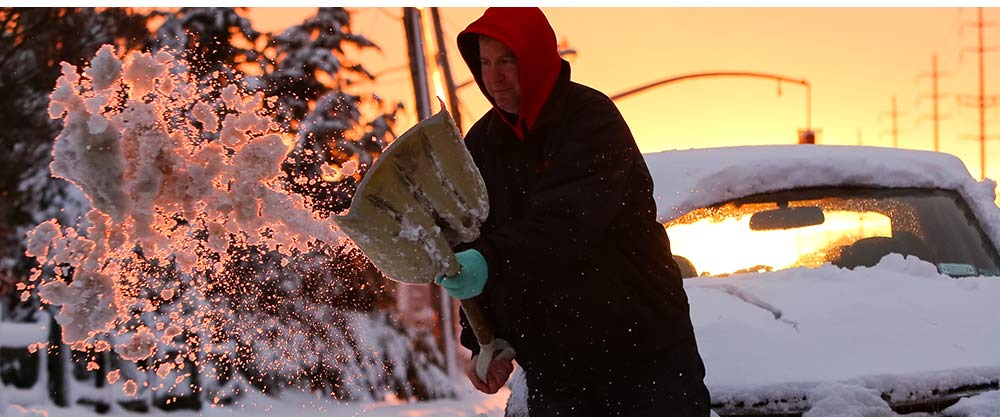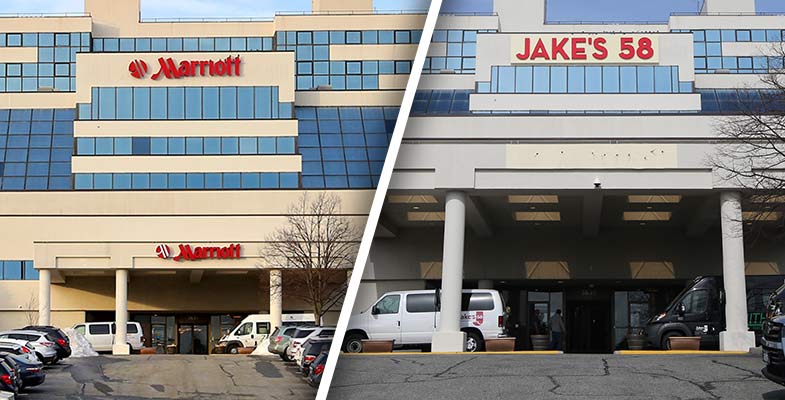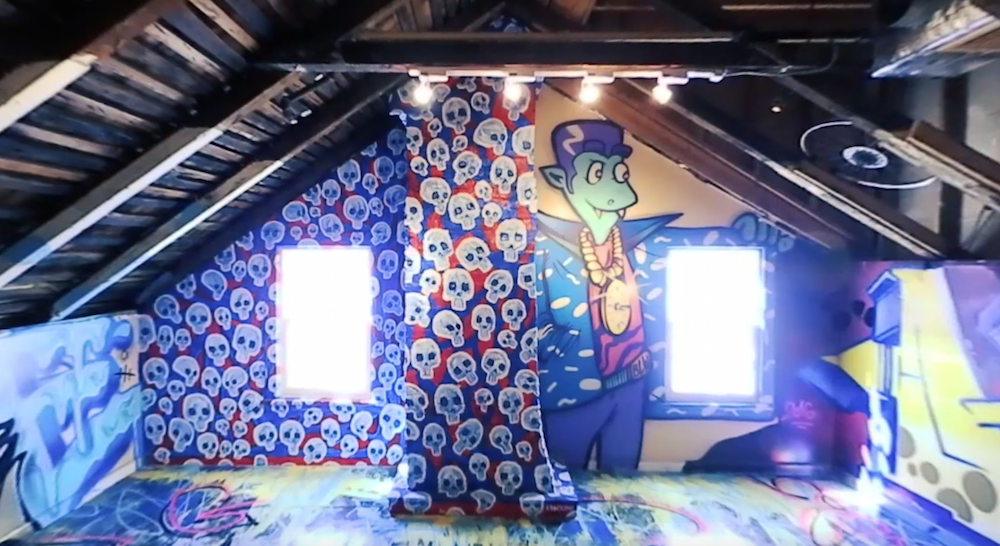360 View: Glen Cove graffiti mansion tour
Nearly 150 artists from around the world painted the 9,000-square-foot house.
Take a 360 tour of a graffiti mansion, curated by The First City Project, a community group that invited artists from the area and around the world to turn a historic Glen Cove home into a canvas. (Credit: Newsday / Jeffrey Basinger)
Note: On mobile devices, the 360-degree video experience can be viewed only in the YouTube app.
360 View: Inside cat room at Animal Rescue Fund of the Hamptons
360 View: Inside the cat room at Animal Rescue Fund of the Hamptons
These adoptable cats got up close and personal with our 360-degree camera.
The cats available for adoption at the Animal Rescue Fund of the Hamptons got up close and personal with a 360-degree camera on Wednesday, March 8, 2017. To find out how you can take home one of these furry friends, please call 631-537-0400 or click on www.arfhamptons.org.(Credit: Newsday / Megan Miller)
Note: On mobile devices, the 360-degree video experience can be viewed only in the YouTube app.
The Amtrak and LIRR relationship: It’s complicated

There’s often more than one railroad to blame when Long Island Rail Road service is disrupted at the height of the evening rush hour at Penn Station.
Limited e/b service out of Penn Babylon, Port Jefferson, Port Washington, Ronkonkoma Branches due to Amtrak switch trouble at Penn Station
— LIRR (@LIRR) March 6, 2017
A complicated relationship
Although the LIRR operates the majority of trains running into and out of Penn — the busiest rail hub in the country — the station, its tracks and the tunnels leading to and from the terminal are owned and maintained by Amtrak. The railroad took control of the station from the bankrupt Penn Central Transportation Co. in the early 1970s.
Frequent tensions
The peculiar arrangement has long fueled tensions between Amtrak and the LIRR’s parent agency, the Metropolitan Transportation Authority.
MTA Board members have, over the years, repeatedly called for the authority to take over Penn, arguing that its own workforce is better equipped to address maintenance and repair issues, and would give them higher priority because of their direct effect on LIRR customers.
Placing the blame
The LIRR has said “third party operations,” including Amtrak, were to blame for 1,463 LIRR delays in 2016 — about 8 percent of the agency’s 17,951 delays last year. That was significantly less than the 2,605 third-party-caused delays in 2015.
Past efforts to improve the working relationship between the two rail providers included a push by the LIRR Commuter Council and by Sen. Chuck Schumer (D-N.Y.) to include an LIRR riders’ representative on the Amtrak Board of Directors.
Who foots the bill?
Complicating matters further, even though Amtrak is responsible for maintenance and repairs in Penn and the tunnels, the LIRR foots most of the bill.
Under a nearly 30-year-old “joint facilities agreement,” maintenance costs are divided between Amtrak and the LIRR “in proportion to each party’s level of usage,” according to MTA documents. Amtrak runs 140 trains into and out of Penn on a weekday, compared with nearly 500 LIRR trains.
Clashes between LIRR and Amtrak in recent years have extended past routine service disruptions. The MTA has blamed Amtrak for recent delays in the construction of its massive $10 billion East Side Access megaproject, saying Amtrak has not provided the cooperation it promised, including by taking some tracks out of service on specified nights and weekends, and lending some of its workers to the effort.
Amtrak has said it is continuing to work closely with the MTA to minimize disruptions.
Future challenges for a strained relationship
The tensions between Amtrak and the LIRR could get worse once Amtrak commences a long-discussed plan to repair superstorm Sandy flooding damage in two of the four East River tunnels leading into and out of Penn Station.
Amtrak has said the repair work, which the MTA is largely funding through federal grant money, will require shutting each of the two affected tunnels for one year at a time. That could force the LIRR to reduce the number of rush-hour trains it operates, and magnify any unanticipated service problems that arise while one of the tunnels is down.
Some MTA officials have also expressed resentment over the state’s original plan to renovate the Farley Post office building adjacent to Penn into a state-of-the-art new train hall that would exclusively be used by Amtrak.
In September, Gov. Andrew M. Cuomo announced that he had persuaded Amtrak to share the new space with the LIRR, saying the original plan made “no sense for anyone.”
A new 255,000 square foot Train Hall at the Farley building will house passenger facilities for @LIRR and @Amtrak: https://t.co/bm8krckdU9 pic.twitter.com/kJA8NvnCc1
— Andrew Cuomo (@NYGovCuomo) September 27, 2016
The expansion and reconfiguration of Penn Station could bring some relief for LIRR riders, as could the completion of East Side Access, which will provide the railroad a second Manhattan hub and an extra set of tunnels to and from Long Island. That project is set for completion by the end of 2022.
Long Island’s Third-Track LIRR Makeover

The proposed addition of a third track to the Long Island Rail Road’s Main Line will not only aim to ease the commutes of a half-million LIRR customers, but will also mean a facelift for several locations where the new track will cross.
The state’s estimated $2 billion plan to build a 9.8-mile-long third track beginning this year will also require encroaching on as many as two dozen private properties, including four businesses that could be uprooted and demolished, project officials say.
Despite assurances that the new track will be built entirely on the railroad’s existing right of way, several related improvements, including retaining walls, drainage improvements, and expanded station platforms, will require working or building on privately-owned parcels.
Here’s a look at some of the possible changes in three locations:
New Hyde Park Road crossing, New Hyde Park
According to the project proposal, the current road-grade crossing, seen below, would be eliminated and replaced with an elevated crossing. In addition, nearby business Safeguard Self Storage would be demolished to make way for potential drainage features and a new station parking lot.
Option 1: One possible makeover for this crossing is creating a five-lane underpass instead, with a “kiss and ride” drop-off northwest of the tracks, seen in the rendering below.
Option 2: Another option for this crossing is to create a four-lane underpass, with a “kiss and ride” drop-off southwest of the tracks substation.
Covert Avenue crossing, New Hyde Park
The existing road-grade crossing here would be eliminated, and New Hyde Park Auto Clinic would need to be acquired “in part or in full” to accommodate that.
The new Covert Avenue crossing would require raising the LIRR tracks roughly 5 feet and constructing a two-lane underpass with a sidewalk, as seen in the rendering below.
School Street crossing, Westbury
Dependable Acme Threaded Products, a business near this crossing, would be leveled to accommodate retaining walls where the road would go under the elevated tracks. In the third-track proposal, the MTA plans to create a two-way underpass and to raise the tracks several feet.
Option 1: One possible plan is relocating the access of another commercial property on the northwest corner of the intersection of School Street and the LIRR tracks to Union Avenue, as seen in this rendering below.
Option 2: A second option would maintain access to the commercial property on the northwest corner, as seen in this rendering below.
Mild Winter, But Beware The Ice of March

Yes, Long Islanders woke up Wednesday to icy roads and wind chill in the single digits after a windy, sleety storm Tuesday.
And, yes, March so far has been a good deal colder than usual for this time of year.
Still, isn’t that all the more reason to marvel at the three preceding months? Overall, this past winter was “a very easy” one, said Bill Korbel, News 12 Long Island meteorologist.
(And, no, he doesn’t have his dates wrong. For those in the meteorological community, the demarcation for winter is nice and neat – from Dec. 1 through the last day of February.)
Winter of 2016-2017 saw an average temperature close to 4 degrees above normal, Korbel said, though there was “above normal snowfall, believe it or not.”
In all, just less than 32 inches of snow fell at Long Island MacArthur Airport, where the Island’s official weather records are kept, with “all but a few inches” arriving with two major storms.
How mild was it?
The average for the season was 36.9 degrees, which is 3.9 degrees above normal. This winter was fifth warmest at Long Island MacArthur Airport, where records have been kept since 1984.
DECEMBER
 36.6°
36.6°
Average temperature — 1° above monthly norm
JANUARY
 36.2°
36.2°
Average temperature — 5.6° above monthly norm
FEBRUARY
 37.8°
37.8°
Average temperature — 5° above monthly norm
60-degree days in winter
There were 5 days with highs of 60 degrees or above at the airport, though that pales in comparison to 12 days last winter.
Feb. 19 and 25 saw the highest temperature all winter: 65 degrees. Meteorologist Korbel, on Feb. 19, “celebrated by hitting golf balls at Eisenhower park,” where “the driving range was very crowded.”

Irene and Greg Simone of Mineola brought daughters Lyla, 3, and Hanna, 1, to Jones Beach as temperatures reached the 60s on Feb. 24. Photo by Steve Pfost.
What a difference a day made
Feb. 8: A high of 62 degrees
With high temperatures near 60 degrees, Ginny Montaperto of Farmingdale basked in the sun with her dog Charlie on a bench at Belmont Lake State Park in West Babylon on Feb. 8. Twenty-four hours later, snow blanketed the same spot.

Photos by Barry Sloan.
Feb. 9: A full-blown blizzard
The blizzard that came after one of the winter’s warmest days packed a lot of punch. Long Island saw snow totals from 12 to 16 inches, and snow fell at rates of 1 to 3 inches an hour, and up to 4 inches per hour in some spots.

Andy Martinez of Brentwood helps push a taxi out of snow on Motor Parkway in Central Islip on Feb. 9. Photo by James Carbone.
MacArthur Airport reported 14.3 inches of snow, sustained winds of 38 mph and peak gusts of 48 mph.
One added attraction of this storm: thundersnow!
This is what thundersnow sounds like https://t.co/ivC7jtVCkI pic.twitter.com/D0M9HRT8Hr
— CNN (@CNN) February 10, 2017
Great loop by Neil Stuart from @NWSAlbany showing yesterday's Nor'easter #Niko and all the #thundersnow observations (lightning strikes) pic.twitter.com/Cc9zZEwXTr
— Michael Ventrice (@MJVentrice) February 10, 2017
How this year stacks up
The data stretch that goes back the furthest for monthly snowfall on Long Island is that recorded at Brookhaven National Laboratory, going back to 1947. Here are the highlights for the entire snow season, from October through April.
 4.5 inches
4.5 inches
Record low at BNL, 1997-98
 42 inches
42 inches
Snowfall total so far this winter
 90.75 inches
90.75 inches
Record high at BNL, 1995-96
Long Island didn’t escape the cold entirely
Though the overall average temperature for this winter was above normal, there were still some chilly days.
The lowest temperature was 4 degrees on Jan. 9. There were 7 days with with highs at or below freezing, compared to the norm of 16.9 days.
There were 60 days with lows at or below freezing, lower than the typical 68.4 days.

Blake Festinger, 6, takes a ride at Kalers Pond in Center Moriches on Jan. 8. Photo by John Roca.
What does it mean for spring?
Long Islanders who are allergy sufferers should take note of a potential downside of above-normal temperatures: the earlier arrival of pollen. Earlier warmth translates to an earlier start to the growing season — which means the earlier appearance of the allergy sufferer’s nemesis.
But it’s hard to make a precise call on pollen timing. Indeed, tree “budbreak” can be influenced by many factors, said Alice Raimondo, with the horticulture diagnostic lab at Cornell Cooperative Extension of Suffolk County. They could include tree health and age, soil moisture and air and soil temperatures, she said.
So, this mid-March splash of sleet and stretch of freezing days could mean somewhat of a reprieve.
Sources: National Weather Service, Upton office; Northeast Regional Climate Center
Is Long Island’s New Casino Working? You Bet.

Jackpot.
Nearly three months after Suffolk OTB opened its first video lottery casino in Islandia, heavy customer demand and an expedited construction schedule are allowing the betting parlor’s operator to finish installing 1,000 electronic gaming machines ahead of schedule, officials said.
Officials said the casino, which is expected to help the bankrupt Suffolk OTB pay off about $15 million in debt, has been a success since it opened on Feb. 27 at Jake’s 58 Hotel & Casino on the north service road of the Long Island Expressway. Buffalo-based casino operator Delaware North more than doubled the number of video lottery terminals there earlier this month.
Time to play the games
The casino will have all 1,000 machines installed by this week – that’s the maximum allowed under the 2013 state law that authorized VLT casinos in Suffolk and Nassau counties.


Among the additions on May 1 were tables where customers can choose among electronic versions of traditional casino games such as craps, blackjack, roulette and baccarat.
The new section opening this week features slot-style games with names such as Red Hot Diamonds and Titanic. Throughout the casino, large-screen televisions are tuned to sporting events, and servers bring drinks and foods to bettors.
What a difference a week makes
Last month, the average terminal in Islandia generated $778 in daily earnings for Suffolk OTB — more than double the statewide rate of $326 per day.
And revenue kept by Suffolk OTB jumped in the span of a week, when the number of terminals expanded from 300 to about 725.

Revenue kept by Suffolk OTB, last week in April

Revenue kept by Suffolk OTB, first week in May

Expected annual gross revenue, including $164M in profits
Where does the money go?
State Gaming Commission records show that Suffolk OTB earned a total of about $14.03 million from the casino in March and April. Most of that revenue is paid to the state education fund, the gaming commission, vendors and marketing. The remaining 35 percent of OTB’s take is used to pay its operating expenses at the casino.

45%
Goes to the state education fund

35%
Is paid to the casino operator

10%
Is a “marketing allowance” to the casino operator, and another 10% is used to reimburse floor vendors
Some casinos are eligible to take a capital award; Jake’s 58 is not.
Delaware North, the casino operator, struck a deal last year with the Village of Islandia in which the village will be paid a total of $47 million over 20 years. The company has paid the village more than $3 million so far, including about $1.5 million for upgrades to a village park.
Opening day
Hints of the casino’s success could be seen even on opening day. Drawn by rumors, speculation and word of mouth, dozens of Long Islanders lined up on Feb. 27 at Jake’s 58 Hotel & Casino in Islandia hoping to be the first customers of Suffolk OTB’s new video lottery betting parlor.
The casino had received its state approval that day, only a few hours before the first bettors were allowed in.
Moving from Medford
Suffolk OTB had originally planned for the casino to be built on a 32-acre property in Medford, the former site of the Brookhaven Multiplex, pictured at right in the map, near Exit 64 of the Long Island Expressway.

In 2016, after more than a year of controversy over the Medford site, OTB officials and their business partner, Buffalo-based Delaware North, quietly pursued a deal to buy the Islandia Marriott Long Island hotel. In August of that year, the Village of Islandia approved plans to house the casino at the hotel, pictured at left in the map, near Exit 58 on the LIE. Delaware North has since renamed the hotel Jake’s 58.
Why VLTs?
VLTs, or video lottery terminals, are a combination of video games and slot machines.
In New York State, only permitted Native American tribes had been allowed to conduct most types of gaming, but since 2004, the state Gaming Commission has authorized certain sites in New York to allow limited forms of gambling, including VLTs.

Why is it called Jake’s 58?
On Feb. 15, the hotel was formally renamed Jake’s 58, named for the Jacobs family, which owns the hotel’s parent company Delaware North, and Long Island Expressway Exit 58, near the hotel.

Betting against the house
Detractors question whether the Islandia casino’s success is sustainable in the long run, pointing to studies showing that VLT facilities peak in their first years before seeing revenue drop as their novelty wears off.

Assemb. Michael Fitzpatrick (R-St. James) cautioned that Islandia officials should not become too dependent on casino revenues.
“I think it’s still very early. They’re still in the early phase of, they’re the new thing. They’ll enjoy success for awhile, but I think eventually it’s going to level off. I still question whether it’s going to be successful long term,” Fitzpatrick said. “The trustees and the mayor need to be careful with spending in case that gold mine dries up, because that’s what’s happened to other communities.”
Casino opponents sued the village in September, saying the village improperly approved the facility. A decision in that case is expected soon, said Paul Sabatino of Huntington Station, an attorney for the opponents.
What’s happening with Jeff Sessions?

Attorney General Jeff Sessions spoke twice last year with the Russian ambassador to the United States, according to Justice Department officials, but he did not disclose the information in his January confirmation hearings to become attorney general.
Sessions was a Republican senator from Alabama at the time and a member of the Armed Services Committee. However, members of the Senate Foreign Relations Committee typically meet with foreign ambassadors, not Armed Services Committee lawmakers whose responsibility is oversight of the military and the Pentagon. Congressional contact with Russian officials was limited after the invasion of Crimea and because of Moscow’s close relationship with Syria, a pariah for much of the West, according to the Associated Press.
The news of the talks triggered concerns that Sessions, as head of the Justice Department, could end up overseeing investigations into President Donald Trump’s team’s ties to Vladimir Putin’s regime.
What Sessions said during his confirmation
Sen. Al Franken: “If there was any evidence that anyone affiliated with the Trump campaign communicated with the Russian government in the course of this campaign, what would you do?”
Sessions: “I’m not aware of any of those activities. I have been called a surrogate at a time or two in that campaign and I did not have communications with the Russians.”
What Sessions is saying now
Under growing pressure from Democrats and Republicans alike, Sessions agreed Thursday to recuse himself from an investigation into Russian meddling in the 2016 presidential election.
The attorney general said he made his decision after his staff recommended that he recuse himself from any investigation related to the Trump campaign, since he had been involved in that campaign. Sessions added that his announcement “should not be interpreted as confirmation of the existence of any investigation.”
Sessions on Thursday rejected any suggestion that he tried to mislead anyone about his contacts with the Russian ambassador, and previously stated he never met with any Russian officials to discuss issues of the campaign.
He did not clarify whether he had talked via phone or another method in his capacity as a senator with a Russian representative.
What the White House is saying
At an appearance on the aircraft carrier USS Gerald Ford on Thursday shortly before Sessions’ press conference, Trump told reporters that Sessions has his “total” confidence.
Trump’s press secretary, Sean Spicer, also backed Sessions.
Spicer told reporters on AF1 there continues to be "no there there" in investigation into Trump campaign contacts with Russians
— Jim Acosta (@Acosta) March 2, 2017
A White House official also summed up the reports as “the latest attack against the Trump administration by partisan Democrats.”
They continued, “[Attorney] General Sessions met with the ambassador in an official capacity as a member of the Senate Armed Services Committee, which is entirely consistent with his testimony.”
What politicians are saying
Republicans and Democrats alike weighed in, including calls for him to recuse himself from the investigations and calls for him to resign:
AG Sessions should clarify his testimony and recuse himself
— Jason Chaffetz (@jasoninthehouse) March 2, 2017
Jeff Sessions is a former colleague and a friend, but I think it would be best for him and for the country to recuse himself from the DOJ Russia probe.– Sen. Rob Portman (R-Ohio) in a statement.
Very troubled that Attorney General Jeff Sessions had contact with Russian official despite testifying otherwise. https://t.co/ak9sU6EOmk
— Sen. Al Franken (@SenFranken) March 2, 2017
And we need Attorney General Jeff Sessions – who should have never been confirmed in the first place – to resign. We need it now.
— Elizabeth Warren (@SenWarren) March 2, 2017
We need a clear-eyed view of what the Russians actually did so that all Americans can have faith in our institutions.– Rep. Darrell Issa (R-Calif) in a statement.
I’m calling for a special prosecutor & a 9/11 style commission to get to the bottom of Russia's ties to the Trump admin & election hacking.
— Kirsten Gillibrand (@SenGillibrand) March 2, 2017
AG Sessions is not fit to serve as the top law enforcement officer of our country and must resign. https://t.co/5r8KpGQSRT pic.twitter.com/vKSVuvTIf3
— Nancy Pelosi (@NancyPelosi) March 2, 2017
House Speaker Paul Ryan (R-Wis.) on Thursday pointed to Sessions’ statement on recusal and said the attorney general should remove himself only if he is the subject of an investigation.
Sen. Tim Scott (R-S.C.) said he needed to do more research before offering an opinion on the Sessions’ revelations.
“Until then, we’re going to keep our powder dry.”
What Russia is saying
A prominent Russian lawmaker close to the Kremlin is playing down the revelation that Sessions met twice with Russian Ambassador Sergey Kislyak during the American presidential campaign.

Alexei Pushkov, a member of Russia’s upper house of parliament and former head of the lower chamber’s foreign affairs committee, said Thursday on Twitter: “It turns out that almost the entire U.S. elite has ties to Russia … Paranoia knows no bounds.”
Last month, former National Security Adviser Michael Flynn was just forced to resign from his position over communications with Russia’s Ambassador to the U.S. Sergey Kislyak — and Flynn’s subsequent misleading of Vice President Mike Pence.
Trust — not the law — was broken in that case, White House Press Secretary Sean Spicer said after the resignation was announced.
On Wednesday, administration officials said White House lawyers have instructed the president’s aides to preserve materials that could be connected to Russian interference in the 2016 election and other related investigations.
The instructions, which were sent to White House staff on Tuesday, came after Senate Democrats asked the White House and law enforcement agencies last week to keep all materials involving contacts that Trump’s administration, campaign and transition team — or anyone acting on their behalf — have had with Russian government officials or their associates.



